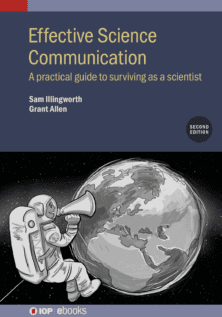
In modern times, the skill of “rhetoric” is often associated with shady lawyers and slippery politicians. We associate rhetorical mastery with style over substance – the ability to use language to trick people into believing something that is not necessarily true. But according to science communicator Sam Illingworth, rhetoric can play a positive role in sharing scientific findings beyond the research community.
Illingworth, a senior lecturer at the University of Western Australia, was speaking yesterday in an online event to promote the second edition of his e-book Effective Science Communication, which he co-authored with atmospheric physicist Grant Allen. Published by IOP Publishing, which also publishes Physics World, it is a practical guide for research scientists, covering inward-facing communication (writing journal articles, grant applications etc) and outward-facing communication (giving outreach presentations, dealing with the media etc).

In his talk, Illingworth mentioned rhetoric as part of a broader discussion about how scientists should carefully consider their audiences when communicating. In doing so, they should think about the three basic elements of rhetoric laid out by Ancient Greek philosopher Aristotle: ethos, logos and pathos.
It’s all Greek to me
Ethos is an appeal to ethics, which means convincing an audience of the credibility of the communicator. Relatively speaking, this is often the easiest part of the triad for scientists. Qualifications bring a recognition of expertise, while academic journals and scientific conferences have reputations often established over many years.
Logos is an appeal to logic, which again most scientists are pretty good at. The scientific method brings a structure to how science is done, which is then reflected in how papers and other communications include clear hypotheses, results and discussions.
Where it can get tricky for researchers is pathos – the appeal to passion. This is the powerful element of rhetoric that regularly gets abused by politicians and the media. For scientists, bringing emotion into the equation can seem to go against the fundamentals of being a good scientist.
“We’re taught from a very young age to be objective, to only present the cold hard facts, whereas I would argue that just presenting the cold hard facts helps to alienate scientists from society,” said Illingworth. “Yes, we need to conduct our scientific research very objectively, but when we’re talking about our research I think it’s important to be honest about our passions.”
Illingworth gave the example of climate change researchers expressing concern about the potential impacts of environmental change on society. But it got me thinking about how pathos can be used to effectively communicate physics, especially some of the more foundational research where the human angle is not so obvious.
Appeal to the emotions
Particle physics and astrophysics often appeal to a sense of awe and wonder, as well as the aesthetic appreciation of all the beautiful imagery. Quantum physics can appeal to a sense of surprise and novelty at the idea nature can behave in such counter-intuitive ways. While advances in medical physics can evoke a sense of joy and empathy – that this technology might be able to help people back to good health.
Yes, we need to conduct our scientific research very objectively, but when we’re talking about our research I think it’s important to be honest about our passions.
Sam Illingworth
Illingworth also spoke about the importance of framing, where small changes in how the same information is presented can lead to significantly different audience responses. To illustrate, he gave an example from a 2009 study by Gächter et al. in which only 67% of PhD students registered early for a conference when doing so was presented as a discount, while 93% did so when the emphasis was instead on a penalty fee for late registration.
Of course, some people reading this may just be looking for some quick practical tips. Illingworth’s new book also has a stack of those: from mastering social media, to working with children, to dealing with nerves before giving a presentation. In his own outreach activities, Illingworth is currently using poetry and games to enable dialogues between scientists and non-scientists.
Indeed, Illingworth spoke about his research and performed some of his poetry in an episode of Physics World Stories podcast recorded at the Blue Dot festival in the UK. You can also have a go at the trivia quiz that Illingworth recently created for Physics World, part of a series launched during the COVID-19 pandemic.
Effective Science Communication (second edition) was published in May 2020 by IOP Publishing, which also publishes Physics World. Watch Illingworth introduce the book as part of IOP Publishing’s Meet the Author webinar series.



